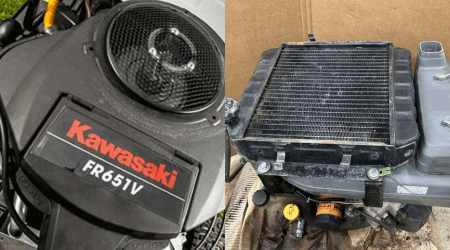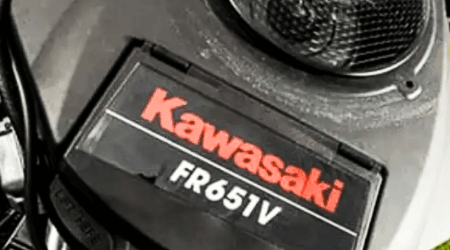Unlock the full potential of your Kawasaki Fr651v engine with the right oil type – a fundamental factor for its performance and durability.
Whether you’re a dedicated landscaper or a diligent homeowner, understanding the nuances of oil selection is key.
In this guide, we illuminate the ins and outs of Kawasaki Fr651v oil types, equipping you with the knowledge needed to make informed decisions. Join me as I explore the recommended oils, their advantages, and the seamless steps to execute an effective oil change.
Elevate your engine’s lifespan and efficiency – let’s begin this journey together!
What Is the Kawasaki Fr651v?
The Kawasaki Fr651v is a powerful and durable V-twin engine commonly used in residential and commercial lawn equipment, such as riding mowers and zero-turn mowers.
With a displacement of 726cc, it offers reliable performance for various outdoor tasks.
Other features include cast-iron cylinder liners, a single-stage air filter, electronic spark ignition system, automatic compression release, a spherical combustion chamber, a rotating metal grass chopper screen, and internally vented carburetor with fuel shut-off solenoid.
Known for its smooth operation and fuel efficiency, the Fr651v engine is popular for landscaping professionals and homeowners alike.
Fr651v Specifications Table
| Displacement | 726 cc (44.3 cu. in.) |
| Number of Cylinders | 2 |
| Bore x Stroke | 3.1 x 3.0 in. (78 x 76mm) |
| Compression Ratio | 8.2:1 |
| Oil Capacity w/filter | 2.1 U.S. qt (2.0 liters) |
| Maximum Power | 21.5 hp (16.0 kW) at 3,600 RPM |
| Maximum Torque | 39.3 ft-lbs (53.2 N·m) at 2,200 RPM |
| Dry Weight | 88.2 lbs (40.0 kg) |
Factors Influencing Oil Selection for Kawasaki Engine
Temperature
In warmer areas, opt for higher viscosity oils to counter thinning due to heat, maintaining proper lubrication. Conversely, colder regions demand lower viscosity oils for smooth start-ups.
Adapting oil viscosity based on temperature ensures engine protection and efficient functioning in various weather conditions.
Climate
Climate dictates oil’s ability to combat specific challenges. In humid areas, moisture buildup can lead to rust; oils with anti-rust additives are crucial.
In drier climates, oils with excellent anti-wear properties protect engines from increased friction. Tailoring oil choices to your climate optimizes engine longevity and minimizes potential issues.
Usage patterns
Light-duty tasks or sporadic use might make conventional oils economical. On the other hand, demanding, frequent usage necessitates synthetic oils with superior resistance to heat and wear.
Engine Age

New engines need break-in oils with specialized additives to facilitate proper component seating. In contrast, mature engines benefit from oils containing anti-wear additives that sustain performance and safeguard aging components.
Adhering to age-specific oil recommendations maintains engine health and performance throughout its lifecycle.
Fuel Quality
Fuel quality affects Inferior fuels can lead to deposits; oils with enhanced detergents manage these issues. High-quality fuels result in fewer deposits, allowing standard oils.
Still, opting for higher-grade oils provides added protection, ensuring the engine remains clean and efficient regardless of fuel quality.
Recommended Engine Oil for Kawasaki Fr651v
SAE 5W-20
SAE 5W-20 ensures easy engine start-up in cold conditions below 32°F. Its low viscosity at colder temperatures allows swift oil circulation, providing rapid lubrication to critical engine components. This oil grade is vital for maintaining optimal engine performance and protection during chilly weather.
SAE 10W-30 and 10W-40
Designed for temperatures above 14°F, SAE 10W-30 and 10W-40 strike a balance between cold and warm weather performance. They offer good flow during start-up while maintaining viscosity at higher temperatures. These oils accommodate varied temperature ranges, making them versatile choices for moderate climates.
SAE 20W-50
SAE 20W-50 maintains consistent viscosity in warmer conditions. This means it is tailored for environments surpassing 32°F.
This oil provides enhanced film thickness at elevated temperatures, safeguarding engine parts against wear and friction. SAE 20W-50 ensures stable protection during prolonged periods of engine operation.
SAE 30
Tailored for temperatures above 50°F, SAE 30 engine oil offers balanced viscosity for moderate heat. It maintains optimal lubrication in warmer conditions without becoming too thin.
This oil grade ensures effective protection against friction and wear, making it a reliable choice for engines operating in moderately warm climates. It guarantees smooth performance and extends engine life during milder temperature ranges.
SAE 40
SAE 40 engine oil is specifically formulated to withstand hotter conditions, of upto 68°F,. Its higher viscosity ensures consistent lubrication and prevents oil breakdown even when exposed to elevated temperatures.
SAE 40 oil provides robust protection, minimizing wear and maintaining engine performance during scorching heat. It’s a vital choice for engines operating in warmer climates.
Kawasaki Oil Capacity: How Much Oil Does the Kawasaki Fr651v Require?
The oil capacity of this engine is approximately 1.9 liters (2.0 US quarts) without the oil filter and about 2.1 liters (2.2 US quarts) with the oil filter. Proper oil levels ensure effective lubrication, cooling, and debris removal from engine components, enhancing overall efficiency.
Follow the manufacturer’s guidelines and recommendations for oil capacity to prevent both underfilling and overfilling. Underfilling can lead to inadequate lubrication and potential engine damage, while overfilling can result in excessive pressure and reduced oil circulation.
Regularly checking and maintaining the proper oil level is a straightforward yet vital task to ensure your Kawasaki Fr651v engine operates smoothly.
Prior to performing an oil change or top-up, consult the engine manual to confirm the exact oil capacity and recommended oil type for optimal performance.
You’ll not only be safeguarding your engine’s health but also ensuring its consistent and reliable operation over time.
Steps to Check Oil in Kawasaki Fr651v
Follow these steps on a regular basis to ensure your Kawasaki FR651V engine’s oil level is maintained correctly, contributing to its overall longevity and optimal performance.

1). Prepare the Engine: Let the engine cool off. Park on a level surface to get accurate oil level readings.
2). Locate the Dipstick: The dipstick is often color-coded (yellow) for easy identification. It’s usually situated on the side of the engine.
3). Remove and Wipe the Dipstick: Pull out the dipstick, wipe it clean with a cloth, and reinsert it fully to get an accurate reading.
4). Check the Oil Level: Remove the dipstick again and observe the oil level. There are usually two marks (low and high) or a cross-hatched area indicating the appropriate range.
5). Add Oil if Necessary: If the oil level is below the recommended range, gradually add small amounts of the appropriate oil type. Check the level regularly to avoid overfilling.
6). Reinsert the Dipstick: After adding oil, reinsert the dipstick completely for a proper seal.
7). Final Check: Pull out the dipstick once more, ensuring the oil level is now within the recommended range.
8). Secure the Dipstick: Push the dipstick back into its slot securely.
9). Dispose of Oil Properly: If you’ve overfilled, consider draining the excess oil into a proper container to avoid environmental contamination.
10). Record and Monitor: Note the date and oil level. Regularly monitor the oil level and top up as needed based on usage.
Kawasaki Fr651v Oil Change: Step-by-Step
When it’s time for an oil change on your Kawasaki Fr651v engine, following a systematic process ensures proper lubrication, optimal performance, and prolonged engine life for lawn and garden tractors.
Here’s a detailed step-by-step guide:
Position on Level Ground
To begin, park your Kawasaki Fr651v on a level surface. This foundational step ensures that the oil is evenly distributed within the engine, enabling accurate measurements and efficient drainage during the oil change.
Warm Up the Engine
Before proceeding with the oil change, allow the engine to run for approximately 3 minutes. This preliminary warming of the engine oil assists in improving the flow of the oil during drainage, making the process more effective.
Engine Shutdown
Once the engine has been warmed up, turn it off. This critical safety step prevents any potential mishaps or hot oil splatters during the oil change procedure.
Drain Plug Removal
Locate the oil drain plug, usually positioned beneath the engine. Utilize a wrench to carefully loosen and remove the drain plug, preparing for the oil to start flowing out.
Oil Drainage
As the drain plug is removed, guide the old oil into a suitable container placed underneath the engine. Allowing gravity to assist in the drainage process facilitates the removal of a significant portion of the used oil.
Refill with Fresh Engine Oil
With the old oil fully drained, it’s time to refill the engine with clean and fresh oil. Refer to the manufacturer’s recommendations for the appropriate type and quantity of oil recommended in the oil gauge.
Dispose Responsibly
Responsible disposal of the drained oil is essential for environmental conservation. Many recycling centers and automotive shops accept used oil for proper disposal, contributing to reducing the ecological impact of used motor oil.
Kawasaki Fr651v Engine Oil Problems
The following are some of the issues that can arise from improper engine oil maintenance or usage:
Increased Mechanical Damage
Inadequate or contaminated oil can lead to increased mechanical wear. Oil serves as a protective barrier, reducing friction between moving parts.
Insufficient lubrication can result in heightened wear and tear, potentially leading to premature component failure and costly repairs.
Reduced Engine Performance
Engine oil problems, like using the wrong viscosity or degraded oil, can hinder engine performance. Properly formulated oil maintains consistent viscosity across temperature ranges, ensuring optimal lubrication.
Poor-quality or degraded oil may struggle to provide the required protection, reducing power output and overall performance.
Overheating
Engine oil plays a crucial role in dissipating heat. If the oil cannot effectively carry away heat from engine components, the engine’s temperature can rise beyond acceptable levels.
Overheating can cause engine parts to expand excessively and result in mechanical stress, potentially causing permanent damage.
Engine Failure
Perhaps the most severe consequence of oil problems is engine failure. Inadequate lubrication can lead to severe friction, overheating, and irreversible damage to critical components.
Left unaddressed, these Kawasaki Fr Engine problems can culminate in complete engine failure, necessitating costly repairs or even engine replacement.
Impaired Fuel Efficiency
Engine oil problems can adversely affect fuel efficiency. Poor-quality oil or oil that’s beyond its service life can increase internal friction and resistance within the engine.
This extra load demands more energy, leading to decreased fuel efficiency. Maintaining the correct oil quality and levels helps preserve optimal engine efficiency and reduces fuel consumption.
Emission and Environmental Impact
The condition of engine oil directly impacts emissions and the environment. Contaminated or degraded oil can produce more harmful emissions and pollutants, polluting air and soil.
Regularly changing and disposing of oil properly reduces environmental impact and ensures compliance with emission standards, benefiting the engine’s performance and the environment.
Maintenance Tips for Kawasaki Fr651v Oil Type
Replacing the Oil Regularly
Scheduled oil changes are essential for preserving engine health. Old oil can lose its lubricating properties and accumulate contaminants, leading to increased wear.
Following the manufacturer’s recommendations for oil change intervals ensures optimal lubrication and extends the engine’s lifespan.
Inspecting Oil Levels Regularly
Routinely check the oil level using the dipstick. Maintaining the proper oil level prevents both overfilling and underfilling, ensuring effective lubrication and preventing potential engine damage. Regular checks also help detect any leaks or abnormal oil consumption.
Using a Premium Oil Filter
Invest in a high-quality oil filter that effectively removes impurities from the oil. A new oil filter ensures cleaner oil circulation, minimizing debris and contaminants that could otherwise contribute to engine wear and reduced performance.
Following Manufacturer Recommendations
Adhere to the manufacturer’s guidelines for oil type, viscosity, and change intervals. Manufacturer recommendations are based on extensive testing to ensure optimal engine performance, longevity, and warranty compliance.
Consider Operating Conditions
Adjust your maintenance routine based on usage and operating conditions. If your equipment is subject to heavy use, extreme temperatures, or dusty environments, more frequent oil changes might be necessary to counter increased wear and contamination.
Proper Storage
Store your equipment in a sheltered environment when not in use. Exposure to the elements can lead to moisture accumulation in the oil, resulting in degradation and reduced lubricating properties. Storing equipment properly helps maintain oil quality.
Use Genuine Parts
When replacing oil or filters, opt for genuine Kawasaki parts. These parts are designed to meet the engine’s specifications and quality standards, ensuring the best performance and protection for your Fr651v engine.
Document Maintenance
Keep records of oil changes and maintenance activities. This documentation serves as a reference for tracking the engine’s history, making it easier to schedule future maintenance and address any emerging issues promptly.
Related post:
FAQs
What oil does the Kawasaki Fr651v take?
The Kawasaki Fr651v engine is compatible with various oil types, primarily determined by ambient temperature. For temperatures below 32°F, SAE 5W-20, SAE 10W-30, or SAE10W- 40 are okay. In temperatures exceeding 32°F, SAE 20W-50, SAE 30, SAE 40 can be used, each offering suitable viscosity for optimal lubrication across different weather conditions.
What is the recommended oil change interval for the Kawasaki Fr651v engine?
Kawasaki recommends changing the oil in the Fr651v engine after every 50 hours of operation or at least once a year, whichever comes first. However, usage patterns, environmental conditions, and oil quality might influence the frequency. Inspecting oil levels and color helps determine if an earlier change is necessary.
Can I use synthetic oil in the Fr651v engine?
Yes, synthetic oil can be used in the Kawasaki Fr651v engine. Synthetic oils offer improved resistance to breakdown under high temperatures and prolonged usage. They also provide better cold-weather start-up performance. While synthetic oils generally enhance engine protection, ensure they meet the manufacturer’s specifications and recommendations for the best results.
See also: Craftsman 140cc lawn mower oil type.
Can I use oil additives or stabilizers in the Kawasaki Fr651v engine?
It’s not necessary to use oil additives or stabilizers in the Kawasaki Fr651v engine. Modern engine oils are formulated to meet specific performance requirements. Additives or stabilizers might upset the oil’s balance and affect its performance. Following the manufacturer’s recommended oil type and change intervals is the best practice for maintaining engine health and longevity.
Is it safe to mix different oil brands or types?
No. Avoid mixing different oil brands or types in the Kawasaki Fr651v engine. While it might not immediately harm the engine, mixing oils can result in inconsistent performance and reduced lubrication efficiency. It’s best to stick to a single oil type and brand that meets the manufacturer’s specifications for consistent and reliable engine operation.
Final word
Understanding the appropriate oil type for your Kawasaki Fr651v engine is integral to responsible maintenance. The right oil ensures optimal lubrication, temperature regulation, and engine performance.
Neglecting this crucial aspect can lead to reduced efficiency, increased wear, and potential engine damage. Armed with the knowledge in this guide, you’re equipped to make informed decisions for your engine’s well-being, extending its lifespan and ensuring reliable operation.
So, whether you’re a dedicated landscaper or a homeowner tending to your lawn, remember that choosing the right oil type isn’t just an option—it’s a key to unlocking the full potential of your Kawasaki Fr651v engine.
